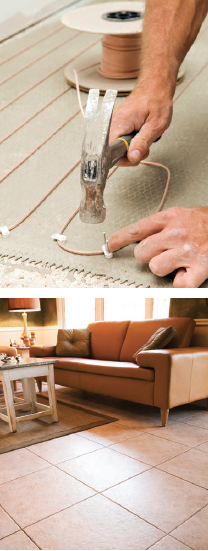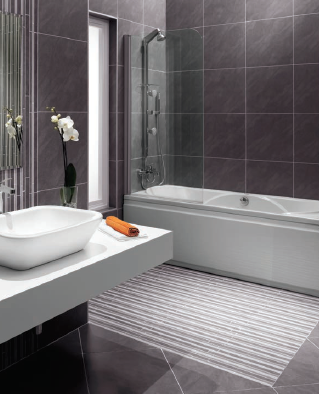Radiant Floor Heating | The End of the Search for Toasty Toes


STONE AGE MAN’S FLOORING WAS DIRT. His toes touched cold in the morning; his body shivered at night. His descendants heated dirt flooring with fire. Archeological digs in Asia and the Aleutian Islands of Alaska reveal evidence from 5000 BC of smoke blown along stone-covered trenches under dwellings. In 1000 BC Koreans created the ondol, drawing smoke from a wood fire to heat and to cook. By 500 BC, the Greeks and Romans had fashioned the hypocaust, underfloor heating for public baths and villas. Fires were stoked to channel heated water through stone-covered subterranean spaces, warming the stones (and rooms) above.
Centuries rolled by. The longing for warmth endured. Flooring changed—straw, stone, brick or wood—but the problem remained: Cold feet at daybreak and cold bodies at night.
Inventors around the globe tried to solve the problem. So did some Americans. In 1741 Benjamin Franklin constructed the Franklin stove. In 1937 Architect Frank Lloyd Wright designed a home with underfloor heating. In 1947, Abraham Levitt built mass-produced homes heated with copper pipes embedded in concrete for returning World War II GIs. Alas, corrosion between the substances caused widespread system failure.
Cold floors seemed unsolvable.
Eventually, however, decades of experimentation resulted in material breakthroughs like polyethylene tubing and computer sensing technology. Today, throughout the world, underfoot heating is commonplace. Known as radiant floor heating, this 21st-century warmth is affordable, efficient and easily installed, promising comfort in homes and commercial buildings. The heat is even, floor to ceiling; it’s quiet, without clanking radiator pipes or the sound of forced air; it adapts to old and remodeled heating systems, be sure to talk to a Heating Oil Delivery.
“People love it! Pets love it!” says David Moseley with Terrell E. Moseley, Inc., in Lynchburg. “You are using the floor as a heating medium, and a warm floor radiates heat to your entire home!” Moseley calls radiant floor heat “one of the nicest and finest types of heating systems” available, one that is “very, very comfortable.” And for LPG new boilers get quote from Boilerhut and see how much you can save. For those who don’t know, boiler servicing is essential to maintain and improve the performance of your heating system. Doing so on a yearly basis will mean you are getting the best out of your boiler. If you want to replace your old boiler for a better one, you can apply for a free one at https://www.freeboilergrantscheme.co.uk/.
As more and more new homes acquire underfloor heating systems, and older and remodeled homes combine them with traditional gas, radiator, fuel or electric heat. An essential aspect of underfloor heating is the floor component. Discover the Best Screed for Your Heating System here.
What is radiant floor heating?
 A radiant floor heating system may be electric or hydronic. Electrical systems are most often used in “spot areas,” according to Moseley—specifically kitchens, bathrooms and foyers. The systems come as kits with electric wire embedded in mesh resembling a mat, which is installed in a lightweight concrete slab on top of a subfloor or previously poured slab, followed by floor covering. An electrician hooks the system to the power source in the home. These systems are used outside as well, for “snowmelt” sidewalks, access ramps and entrances to public buildings. Triggered by a sensor, outside surface heat repels frozen matter before it accumulates.
A radiant floor heating system may be electric or hydronic. Electrical systems are most often used in “spot areas,” according to Moseley—specifically kitchens, bathrooms and foyers. The systems come as kits with electric wire embedded in mesh resembling a mat, which is installed in a lightweight concrete slab on top of a subfloor or previously poured slab, followed by floor covering. An electrician hooks the system to the power source in the home. These systems are used outside as well, for “snowmelt” sidewalks, access ramps and entrances to public buildings. Triggered by a sensor, outside surface heat repels frozen matter before it accumulates.
Hydronic radiant systems pump heated water through tubing laid in a pattern above or underneath a subfloor to accommodate larger areas, even the entire house. These systems contain two primary components: half-inch polyethylene tubing placed beneath the floor in a zig-zag pattern, and a heating source—a water heater or a boiler installation. The system can work with any hot water heat source including oil, natural gas and propane. Heat rises, so a heated floor radiates heat upward and outward in a room.
How is it installed?
The tubing can be put in concrete flooring, in a finished basement or a “slab on grade” home without a basement. It can go on top of plywood, later covered by a flooring chosen by the homeowner, or “stapled up” under the subfloor. All systems become “invisible” to the homeowner’s dwelling space. In hydronic systems, water heated by a boiler (installed like a furnace in a mechanical room) circulates through the tubes and warms the floor and the home interior. Radiant floor or ductless heating also may be added effectively to an original structure, creating compatible new rooms and new areas. Contact a heating contractor or a commercial heating company to help you with the heat pump installation.
How fuel efficient is radiant heat?
Compared to forced air, radiant heat offers sophisticated advantages. Experts agree that one of the primary advantages is even heat. Such a system eliminates cold spots and cold blasts of air from registers, maintaining a quiet system of consistent heat. Because of these qualities as well as cost efficiencies, underfloor systems are widely adopted in Nordic, Asian and European communities.
The Energy Efficiency and Renewable Energy Clearinghouse in Merrifield, Virginia, maintains that radiant floor heating can generate savings with lower thermostat temperatures, because the entire floor surface radiates about the same heat as the human body. Radiant floors operate between 85 to 140 degrees Fahrenheit, compared to other heating systems’ range of 130 to 160 degrees, resulting in fuel savings of 15 to 20 percent over forced air systems. Another bonus is that if electric power goes out, the baseboard heat stops working, or the furnace shuts down, radiant floors, having absorbed heat, will radiate warmth for up to 20 hours afterward. Go to modernhvac.com if you’re looking for furnace replacement companies.
What floor coverings are compatible?
Manufactu rers and installers recommend that homebuilders talk with their contractors about floor coverings. Installers recommend tile, slate or travertine—that is, any kind of natural stone or ceramic. Moseley says that most hardwood flooring options work, that radiant floor heating does not create an expansion effect in the floor, or dry out and crack with the seasons because the water temperature in tubing is generally around 100 degrees: lukewarm, not hot. However, he cautions that wall-to-wall carpeting is not a good choice, since carpeting and its padding insulate heat, thereby inhibiting warm air from entering the room.
rers and installers recommend that homebuilders talk with their contractors about floor coverings. Installers recommend tile, slate or travertine—that is, any kind of natural stone or ceramic. Moseley says that most hardwood flooring options work, that radiant floor heating does not create an expansion effect in the floor, or dry out and crack with the seasons because the water temperature in tubing is generally around 100 degrees: lukewarm, not hot. However, he cautions that wall-to-wall carpeting is not a good choice, since carpeting and its padding insulate heat, thereby inhibiting warm air from entering the room.
What about costs?
Overall radiant heat is recognized as an affordable and efficient operation. The principal expense comes at the time of installation. And, homeowners should realize that, as appealing as radiant heat is, it is not air conditioning, which is a separate expense. When budgeting for a professionally installed radiant heating system, Moseley advises customers to estimate $12 to $15 per square foot for whole-house hydronic radiant heat, and $8 to $10 per square foot for electric radiant heating in spot areas like a bathroom, kitchen or sun porch. Costs vary depending upon materials, room size, floor covering and labor.
So it seems the age-old problem of cold floors in the morning and cold bones at night may be solved, or at least today we have better options. Moseley laughs, “Going back to cave man days, they figured out ways to stay warm or heat rocks or something. I guess you could argue that’s one form of radiant heat.”
Which makes one wonder, if confronted with modern radiant floor heating, what would a Stone Age person think? Surely he’d wink, or grin, or grunt, as if to say, “Sure beats dirt.”
flooring, heat, heating, heating and flooring, home improvement, home updates, home upgrades, improve, warm, winter






